click here
to download today's notes in more printer friendly Microsoft WORD format
Music today was "J'ai ete au Zydeco," a selection from the Best of
Beausoleil CD.
The Experiment #3 reports and the 1S1P Assignment #2 reports were
collected
today.
Quiz #3 is Wednesday this week. You'll find the times and
locations of
this week's reviews on the Quiz #3 Study Guide pt. 3
Class today began
with a greeting
(and a bit of a story)

NATS
101 World is the 50 minutes or so that many of you spend in class three
days a
week. Hopefully your visit to NATS 101 World isn't an unpleasant
experience.
There's a funny thing that seems to happen once or twice a
semester. NATS
101 World and the Real World intersect or overlap briefly. Once
or twice
a semester, you'll be out in the Real World and something will grab you
and
pull you back into NATS 101 world.
This happened to the course instructor over the weekend. He was
in his
kitchen reading the Sunday newspaper when he saw the following article:
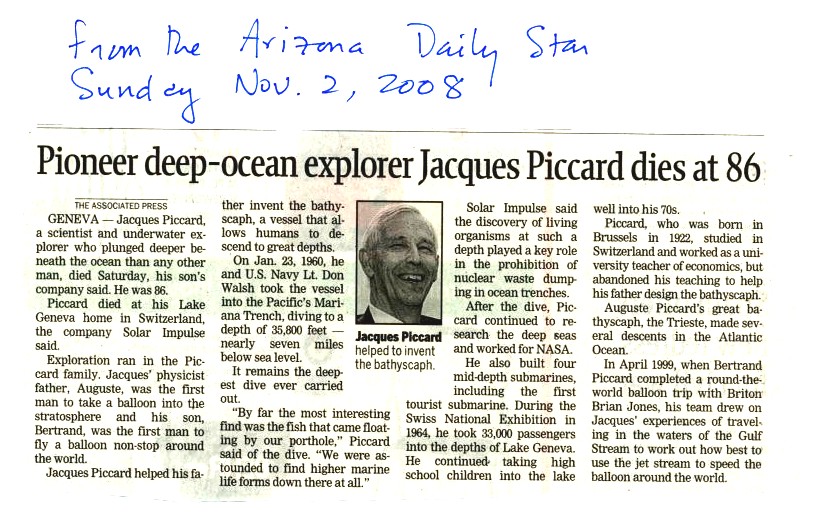
You may remembered having heard about Auguste
Piccard earlier in the
semester. He was part of the two man team that first traveled
into the
stratosphere by balloon (I'll try to squeeze the video of that
adventure into
class at some point before the end of the semester). Jacques was
Auguste's son. We watched a brief video segment, at the end of
class
today, showing Auguste and Jacques travelling to a depth of
10,000 feet
in the ocean. It was a trial run of their bathyscaph. Later
Jacques
and US Navy Lt. Don Walsh would descend to the deepest point in the
ocean
(35,800 feet). Jacques' son Bertrand was part of the two-man team
that
completed the first non-stop trip around the globe by balloon.
We'll finish
precipitation
formation today

The collision
coalescence process is pretty straight forward. It doesn't
produce much of a variety in types of precipitation particles - really
just
rain. Virga is rain that evaporates before reaching the ground.
The ice crystal process on the other hand is more complex.

both in regards to what goes on inside the cloud and also in the types
of
precipitation that can fall from the cloud.
Before we look at how the ice crystal can produce such a variety of
precipitation particles we will quickly review the process in cold
clouds that
gets everything started.

The ice crystal process works in the mixed phase region of cold clouds,
where
you find a mixture of ice crystals and supercooled water
droplets. In the
right figure, two arrows of evaporation from the water droplet are
shown
(different from the three arrows drawn in class last Friday - don't let
that
bother you). How many arrows should be drawn to accurately
represent
evaporation (sublimation) from the ice crystal (0, 1, 2, or 3)?

The ice crystal
will be
evaporating so there should be atleast one arrow. The ice crystal
won't
evaporate as quickly as the water droplet however. So the correct
answer
is 1 arrow.
How many arrows of condensation should be drawn going to the water
droplet and
to the ice crystal?

In order for the
water droplets to
be in equilibrium there must be 2 arrows of condensation to balance the
2
arrows of evaporation. The rate of condensation depends on the
amount of
water vapor in the air. Since the ice crystal is surrounded by
the same
moist air as the water droplet, there will be 2 arrows of condensation
going to
the ice crystal. The ice crystal will grow even when the water
droplets
do not.

Once an ice
crystal has grown a
little bit it becomes a snow crystal (this figure is on p. 102 in the
photocopied classnotes). Snow crystals can have a variety of
shapes
(called crystal habits) depending on the conditions (temperature and
moisture)
in the cloud. Dendrites are the most common because they form
where there
is the most moisture available for growth. With more raw material
available it makes sense there would be more of this particular snow
crystal
shape.

Here are some actual photographs of snow crystals (taken with a
microscope). Snow crystals are usually 100 or a few 100s of
micrometers
in diameter (tenths of a millimeter in diameter).
You'll find some much better photographs and a pile of addtional
information
about snow crystals at www.snowcrystals.com

A
variety of things can happen once a snow crystal forms. First it
can
break into pieces, then each of the pieces can grow into a new snow
crystal. Because snow crystals are otherwise in rather short
supply, ice
crystal multiplication is a way of increasing the amount of
precipitation that
ultimately falls from the cloud.

Several snow
crystals can collide
and stick together to form a snowflake. Snow crystals are small,
a few
tenths of a millimeter across. Snowflakes can be much larger and
are made
up of many snow crystals stuck together. The sticking together or
clumping together of snow crystals is called aggregation.
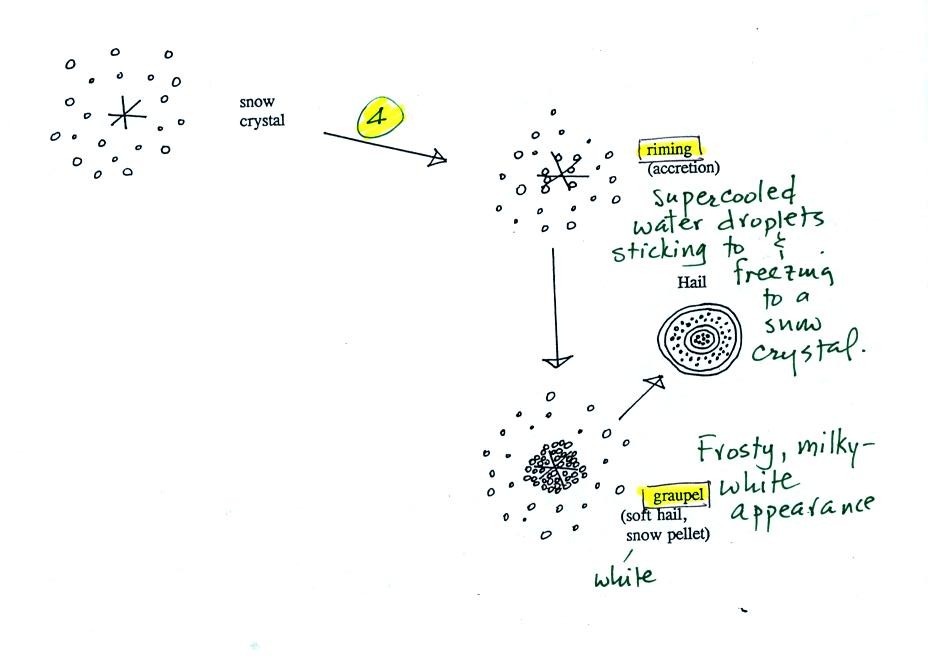
Snow crystals can
collide with supercooled water droplets. The
water
droplets may stick and freeze to the snow crystal. This process
is called
riming or accretion (note it is really the same idea as collision and
coalescence). If a snow crystal collides with enough water
droplets it
can be completely covered with ice. The resulting particle is
called
graupel (or snow pellets). Graupel is sometimes mistaken for hail
and is
called soft hail or snow pellets. Rime ice has a frosty milky
white
appearance. A graupel particle resembles a miniature snow
ball.
Graupel particles often serve as the nucleus for a hailstone.
The ice crystal
process can
produce a variety of precipitation particles inside the cloud.
Further
changes can occur once the particle falls from the cloud. The
pictures
were redrawn because I decided the figures on p. 103 were kind of ugly.

In
the example above at left the ice particles (graupel or snow) first
melt and
then evaporate before reaching the ground. Rain that evaporates
before
reaching the ground is called virga.
A similar thing can happen with snow crystals or snow flakes.
They
sublimate away; the streamers of falling precipitation are called fall
streaks
(as far as I'm concerned you can use the name virga for this process
since it
is the same overall idea). You'll see white streamers of snow
falling
from high altitude cirrus clouds fairly often.
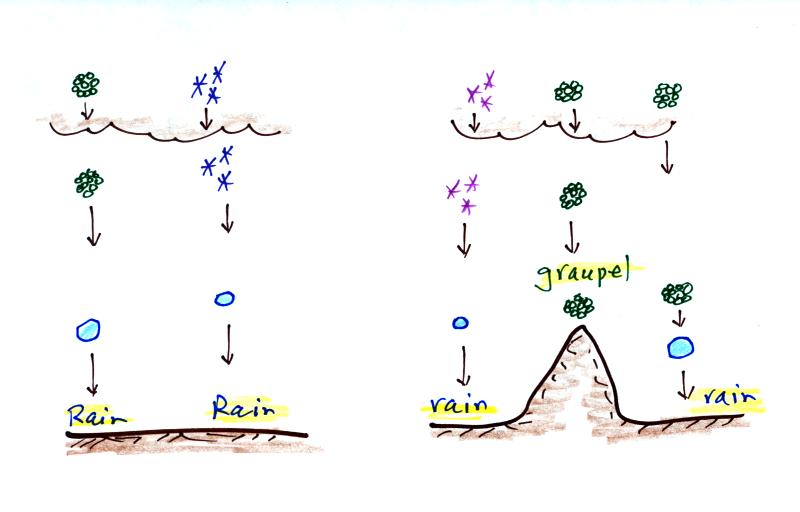
The frozen
precipitation particles
produced by the ice crystal process (graupel or snow) can melt before
reaching
the ground. This would be rain (or drizzle if the drops are
small).
This is where rain in
If you are on a mountain top you might see some of the frozen
precipitation
before it melts. You might see graupel falling from a summer
thunderstorm, for example, while the people in the valley only observe
rain.
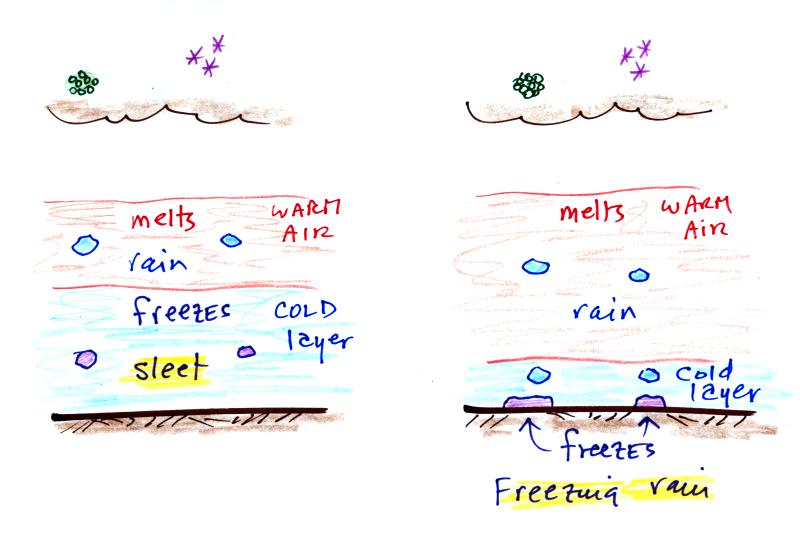
Sometimes the
frozen precipitation
will melt and then fall into a thick layer of cold air and
refreeze. The
resulting particle is called sleet (or ice pellets). Sleet is
rain that
freezes before hitting the ground. The clear ice in sleet is
noticeably
different from the frosty, milky white, rime ice in graupel.
Rain that falls into a shallow cold air layer and only freezes after
reaching
the ground is called freezing rain. It is nearly impossible to
drive
during one of these "ice storms." Sometimes the coating of ice
is heavy enough that branches on trees are broken and power lines are
brought
down. It sometimes takes several days for power to be restored.
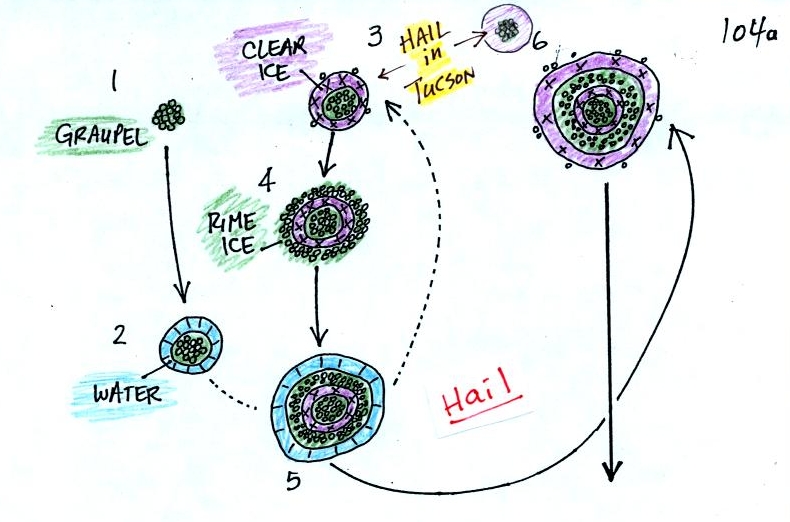
In the figure
above a hailstone
starts with a graupel particle (colored green to represent rime
ice). The
graupel falls or gets carried into a part of the cloud where it
collides with a
large number of supercooled water droplets which stick to the graupel
but don't
immediately freeze. The graupel gets coated with a layer of water
(blue). The particle then moves into a colder part of the cloud
and the
water layer freeze producing a layer of clear ice (the clear ice,
colored
violet, has a distinctly different appearance from the milky white rime
ice). In
In the severe thunderstorms in the Central Plains, the hailstone can
pick up a
new layer of rime ice, followed by another layer of water which
subsequently
freezes to produce a layer of clear ice.
This cycle can repeat several times; large hailstones can be composed
of many
alternating layers of rime and clear ice. An unusually
large
hailstone (around 3 inches in diameter) has been cut in half to show
(below)
the different layers of ice.

Hail is produced
in strong
thunderstorms with tilted updrafts. The figure below wasn't shown
in
class.

The growing
hailstone can fall
back into the updraft (rather than falling out of the cloud) and be
carried
back up toward the top of the cloud. In this way the hailstone
can
complete several cycles through the interior of the cloud.
